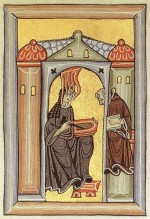“O most noble greening power”

As reported in my previous post, the structure of Hildegard’s poem will be mirrored in my composition: 7 lines of poetry=7 musical sections, the lengths of which are determined by the number of syllables in the hymn. I’m beginning with the first line, “O most noble greening power” (O nobilissima viriditas”). I want “most noble” to be expressed through the nobility of the brass section. There will be seven chords, with durations proportional to the poetic structure. Each will be constructed from perfect fifths, with the final chord containing all... Read The Rest →
Divisions of time and the grid

I think about time. A lot. It’s not an obsession, exactly, but when you’re dealing with a time-based medium like music, you can’t help but notice the various ways that time can bend, twist, and divide itself. Much like a painter, I think about time as a kind of grid. Below, I’ve posted a work by one of my favorite artists, Pat Steir, whose work sometimes includes her own working grid, thus revealing a part of the artistic process usually hidden from viewers. There are some musical endeavors that interface... Read The Rest →
Origins

My colleague Dan Baldwin, conductor of the Luther Orchestra, has invited me to compose a new work for the 2014-2015 season, to be premiered in Decorah and then subsequently performed in Vienna, Austria, as part of the orchestra’s residency there in January 2015. It’s an opportunity that many composers would covet, as it is increasingly difficult for living composers to hear their music performed by orchestras. Lately, I’ve found that my own creative life revolves around interests in current events (my work “Union Protest,” for example, was a response to... Read The Rest →
